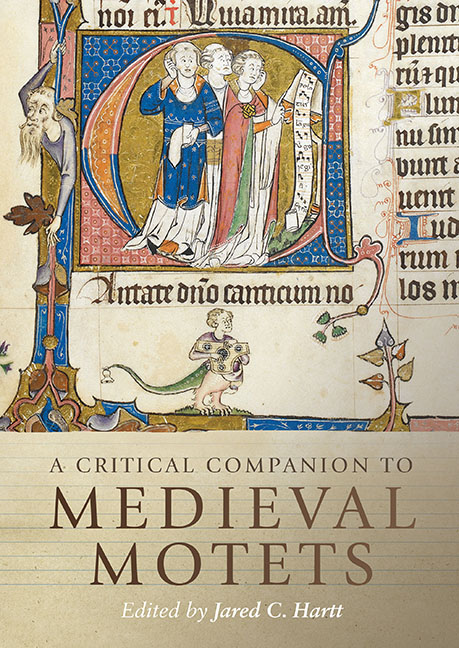Book contents
- Frontmatter
- Dedication
- Contents
- List of Figures
- List of Music Examples
- List of Tables
- List of Contributors
- Preface
- Acknowledgments
- Abbreviations
- Introduction: Approaching Medieval Motets
- 1 The Genre(s) of Medieval Motets
- 2 Origins and Interactions: Clausula, Motet, Conductus
- 3 Tracing the Tenor in Medieval Motets
- 4 Isorhythm
- 5 Notation
- 6 Thirteenth-Century Motet Functions: Views through the Lens of the Portare Motet Family
- 7 A Prism of its Time: Social Functions of the Motet in Fourteenth-Century France
- 8 Motets, Manuscript Culture, Mise-en-page
- 9 Clerics, Courtiers, and the Vernacular Two-Voice Motet: The Case of Fines amouretes / Fiat and the Roman de la poire
- 10 When Words Converge and Meanings Diverge: Counterexamples to Polytextuality in the Thirteenth-Century Mote
- 11 Motets in Chansonniers and the Other Culture of the French Thirteenth-Century Motet
- 12 Building a Motet around Quoted Material: Textual and Musical Structure in Motets Based on Monophonic Songs
- 13 The Duet Motet in England: Genre, Tonal Coherence, Reconstruction
- 14 Materia Matters: Reconstructing Colla/Bona
- 15 Machaut’s Motet 10 and its Interconnections
- 16 A Motet Conceived in Troubled Times: Machaut’s Motet 22
- 17 A Motet Ahead of its Time? The Curious Case of Portio nature/Ida capillorum
- Bibliography of Works Cited
- Select Glossary
- Index of Cited Motets
- General Index
- Studies in Medieval and Renaissance Music
13 - The Duet Motet in England: Genre, Tonal Coherence, Reconstruction
Published online by Cambridge University Press: 21 October 2020
- Frontmatter
- Dedication
- Contents
- List of Figures
- List of Music Examples
- List of Tables
- List of Contributors
- Preface
- Acknowledgments
- Abbreviations
- Introduction: Approaching Medieval Motets
- 1 The Genre(s) of Medieval Motets
- 2 Origins and Interactions: Clausula, Motet, Conductus
- 3 Tracing the Tenor in Medieval Motets
- 4 Isorhythm
- 5 Notation
- 6 Thirteenth-Century Motet Functions: Views through the Lens of the Portare Motet Family
- 7 A Prism of its Time: Social Functions of the Motet in Fourteenth-Century France
- 8 Motets, Manuscript Culture, Mise-en-page
- 9 Clerics, Courtiers, and the Vernacular Two-Voice Motet: The Case of Fines amouretes / Fiat and the Roman de la poire
- 10 When Words Converge and Meanings Diverge: Counterexamples to Polytextuality in the Thirteenth-Century Mote
- 11 Motets in Chansonniers and the Other Culture of the French Thirteenth-Century Motet
- 12 Building a Motet around Quoted Material: Textual and Musical Structure in Motets Based on Monophonic Songs
- 13 The Duet Motet in England: Genre, Tonal Coherence, Reconstruction
- 14 Materia Matters: Reconstructing Colla/Bona
- 15 Machaut’s Motet 10 and its Interconnections
- 16 A Motet Conceived in Troubled Times: Machaut’s Motet 22
- 17 A Motet Ahead of its Time? The Curious Case of Portio nature/Ida capillorum
- Bibliography of Works Cited
- Select Glossary
- Index of Cited Motets
- General Index
- Studies in Medieval and Renaissance Music
Summary
ERNEST SANDERS AND PETER LEFFERTS begin their Grove entry, ‘Sources of English Polyphony 1270–1400’, with the following: ‘It is an indication of the lamentable state of preservation of medieval English polyphony that, strictly speaking, a report on its MS sources has to be so negative.’ The reason for this comment is that there are no surviving English sources comparable to the continental Mo and Ba codices from the thirteenth century, for instance, or to Fauv, Iv, and the Machaut manuscripts from the fourteenth, all of which contain dozens of motets. Instead, we are left mostly with a large number of thirteenth- and fourteenth-century English manuscript fragments, and within these fragments, the majority of the motets are incomplete. Significantly, though, in one source, LoHa, there is a list of contents of a now-lost thirteenth-century manuscript that contains 164 sacred polyphonic compositions, among them 66 motets with two upper-voice texts (moteti cum duplici littera) as well as 15 conductus motets (moteti cum una littera et duplici nota). This indicates that in England, there were indeed manuscripts with extensive motet sections that simply are not extant today.
Despite the lack of surviving complete sources, there remain more than enough motets from England from which to make some general observations regarding style, function, and compositional approach. On the one hand, the surviving motets constitute a homogenous group in several respects. For instance, the poetry is almost exclusively Latin, the subjects are invariably sacred or devotional, and consistent declamation patterns tend to dictate the rhythm of the motet voices; this stands in stark contrast to continental motets in general, which frequently feature French poetry in the courtly love tradition and, beginning in the later thirteenth century, often had less and less concern with traditional, regular declamation. On the other hand, the motet in England exhibits a variety of formal structures and compositional approaches. For example, about half of the English extant motets (or fragments thereof) from the thirteenth century have a tenor drawn from a liturgical source; the other half have so-called pes tenors, in which the foundational melody was either freely composed or converted from an already-existing popular tune. Both tenor types continued to be used in the next century, but there was an increase in the use of secular songs as tenors, though even in such cases the upper voices remained Latin and the subjects liturgical.
- Type
- Chapter
- Information
- A Critical Companion to Medieval Motets , pp. 261 - 286Publisher: Boydell & BrewerPrint publication year: 2018



